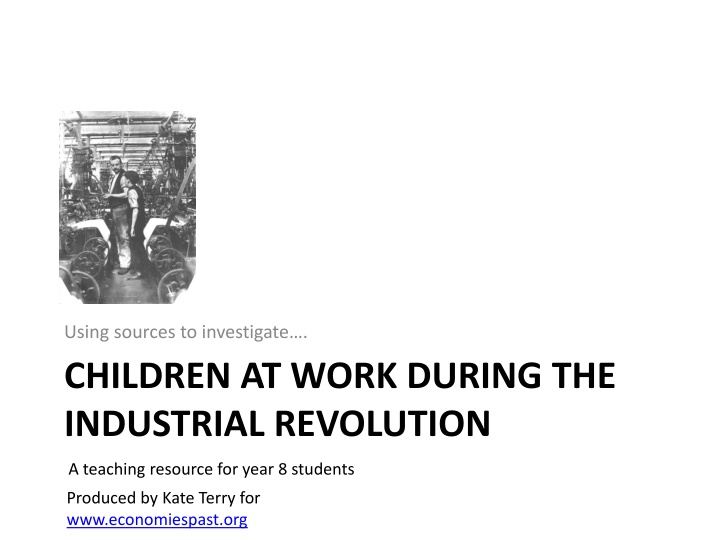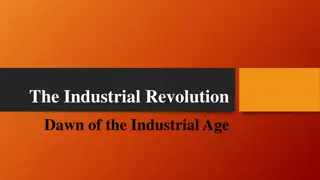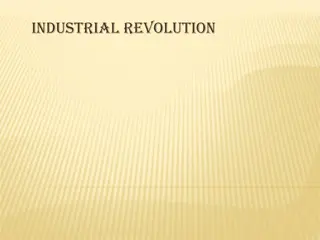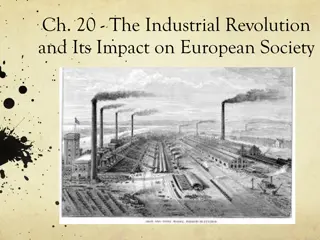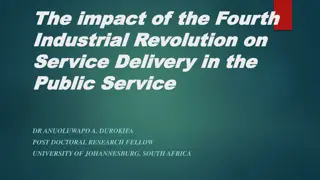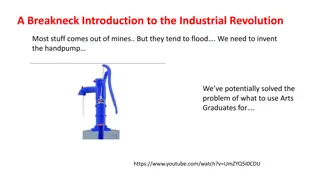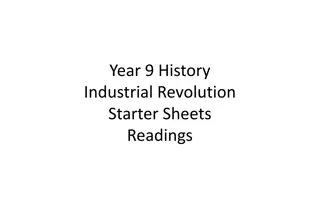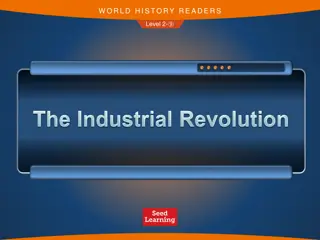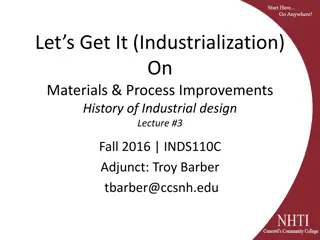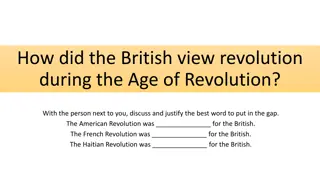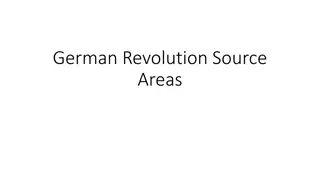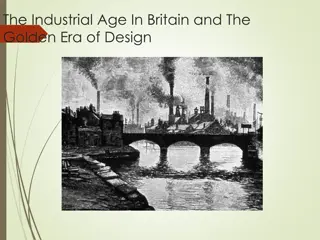CHILDREN AT WORK DURING THE INDUSTRIAL REVOLUTION
Explore the types of work children did during the Industrial Revolution from 1851-1901. Learn about available sources for historians, such as census records, church registers, school logs, newspapers, photographs, poetry, and government reports. Discover how the 1851 census in England and Wales provides valuable information. Access resources on the Economies Past website to delve deeper into this historical period.
Download Presentation

Please find below an Image/Link to download the presentation.
The content on the website is provided AS IS for your information and personal use only. It may not be sold, licensed, or shared on other websites without obtaining consent from the author.If you encounter any issues during the download, it is possible that the publisher has removed the file from their server.
You are allowed to download the files provided on this website for personal or commercial use, subject to the condition that they are used lawfully. All files are the property of their respective owners.
The content on the website is provided AS IS for your information and personal use only. It may not be sold, licensed, or shared on other websites without obtaining consent from the author.
E N D
Presentation Transcript
Using sources to investigate. CHILDREN AT WORK DURING THE INDUSTRIAL REVOLUTION A teaching resource for year 8 students Produced by Kate Terry for www.economiespast.org
This lesson will enable you to: explain some of the sources available to historians from 1851 and how useful they can be explore the kinds of work done by children where you live between 1851-1901. Was there a difference between the work done by boys and work done by girls? identify patterns of change in the employment of children from 1851 and explain possible causes of these.
What kinds of work did children do in your area during the Industrial Revolution? This is a big question that will need a great deal of evidence to answer. What kind of sources or evidence could you, as a historian, use to answer this question? Task 1: exploring sources What sources could you use to find out the type of work that children did in your area in 1851? Explore possible sources on the next slide and discuss which might be the most useful and why.
What sources could you use to find out the sorts of work that children did in your area in 1851? Working with a partner, decide which of these sources would be available to you from 1851 and how useful they might be: Possible source Find out more.. Available in 1851? Useful? http://www.nationalarchives.go v.uk/help-with-your- research/research- guides/census-records/ Census (official count or survey of the population) Church records (e.g. parish registers of baptisms, marriages and burials) https://parishregister.co.uk/ School registers (admission registers and log books) http://www.schoolrecords.org.u k/ https://www.britishnewspapera rchive.co.uk/ Newspapers http://www.directoryphotograp hiccollectionsuk.org/pub/apps/r esources/ Photographs https://www.bl.uk/collection- items/a-voice-from-the- factories-a-poem-by-caroline- norton-about-19th-century- child-labour Poetry https://www.bl.uk/collection- items/report-on-child-labour- 1842 Government reports Other?
The maps that you are about to explore are based on census information, so what information can the 1851 census in England and Wales provide?
What kinds of work did children do in your area during the Industrial Revolution? Task 2: introducing the Economies Past website You or your teacher log on to: www.economiespast.org The maps that you are about to explore are based on census information and have been developed by The Cambridge Group for the History of Population and Social Structure.
What kinds of work did children do in your area during the Industrial Revolution? Select 1851 on the date slider. Select both (male and female). Select Children (10- 12) Select Primary sector to see those children working in agriculture and mining Then gradually zoom into your area to take a closer look! You can hover over where you live to find out the name of your area at this time.
What kinds of work did children do in your area during the Industrial Revolution? Discuss with a partner what this map is showing you. Look closely at the key. The key shows that each colour on the map represents a range of percentages. Sometimes no data is available for a particular date or category. If this is the case, you ll see the area will be grey. If there is no data for your own parish, look at the parish next to it instead. Each range in the key for your chosen map shows you the percentage (%) of children aged 10-12 as part of the total labour force (everyone who was in work whether male, female, adult or child). It s important to remember that what you see is the % of children in employment and not the total number or % of children in the population.
Explore the map for the area where you live. What can you see? Does anything surprise you?
What kinds of work did children do in your area during the Industrial Revolution? Task 3: exploring different maps You now need to explore the maps for your area or parish in more detail to help you answer the question above. Use the grey navigation bar on the right hand side of the screen again for 10-12 year old children in the primary sector. However, this time, explore the 1901 map and discuss any changes with a partner. Then have a look at the same group of children (10-12 year old males and females) working in agriculture only (see button under primary sector ). Next, select only males aged 10-12 working in agriculture only in 1851. Compare this with a later map of the same labour force in 1901. Once you feel confident about moving between the different maps, complete the table that s the most appropriate for you on the next 3 slides. Some help with the terms before you begin: Domestic service: involves a person who works within the employer's household whose responsibilities may include cooking, laundry and ironing, shopping for food and other household errands. Mining: involves mining and quarrying of coal, stone and other minerals or metals such as lead. Textiles: involves the production of cloth rather than the making of clothes from the cloth.
What kinds of work did children do in my area during the Industrial Revolution? Your chosen parish (hover over your area to see the parish name):_____________________________ 1851 Primary sector Secondary sector Tertiary sector % of total labour force in domestic service % of total labour force in agriculture % of total labour force in building & construction % of total labour force in mining % of total labour force in textiles % of total labour force in transport Group Males aged 10-12 years Females aged 10-12 years 1901 Primary sector Secondary sector Tertiary sector % of total labour force in domestic service % of total labour force in agriculture % of total labour force in building & construction % of total labour force in mining % of total labour force in textiles % of total labour force in transport Group Males aged 10-12 years Females aged 10-12 years 1. Which sector employed the most 10-12 year old children (as a % of the labour force) in your parish or area in 1851? 2. 10-12 year old males (as a % of the labour force) were far more likely to be employed in which sector in your parish 1851? 3. What was the most significant change in the employment of 10-12 year old children in your parish between 1851 and 1901? 4. What differences can you see between 10-12 year old male and female employment (as a % of the labour force) in your parish in 1901? 5. What kinds of work are not represented by the maps you have studied?
What kinds of work did children do in my area during the Industrial Revolution? Your chosen parish (hover over your area to see the parish name):_____________________________ 1851 Primary sector Secondary sector Tertiary sector % of total labour force in domestic service % of total labour force in agriculture % of total labour force in building & construction % of total labour force in mining % of total labour force in textiles % of total labour force in transport Group Males aged 10-12 years Females aged 10-12 years 1901 Primary sector Secondary sector Tertiary sector % of total labour force in domestic service % of total labour force in agriculture % of total labour force in building & construction % of total labour force in mining % of total labour force in textiles % of total labour force in transport Group Males aged 10-12 years Females aged 10-12 years 1. Which sector employed the most 10-12 year old children (as a % of the labour force) in your parish in 1851? 2. Which sector employed the most 10-12 year old children (as a % of the labour force) in your parish in 1901? 3. Most females (as a % of the labour force) worked in which sector/kind of work in your parish in 1851? By 1901, had this changed or stayed the same? 4. Write down 3 questions that you could ask to find out more about what you have discovered.
What kinds of work did children do in my area during the Industrial Revolution? Your chosen parish (hover over your area to see the parish name):_____________________________ 1851 Primary sector Secondary sector Tertiary sector % of total labour force in agriculture % of total labour force in domestic service Group % of total labour force in textiles Males aged 10-12 years % % % Females aged 10-12 years % % % 1901 Primary sector Secondary sector Tertiary sector % of total labour force in agriculture % of total labour force in domestic service Group % of total labour force in textiles Males aged 10-12 years % % % Females aged 10-12 years % % % Most children aged 10-12 in the labour force in my area in 1851 worked in __________. By 1901, this was the same/had changed to _______________. There were more boys than girls aged 10-12 employed in (agriculture/textiles/ domestic service) in 1851.
What kinds of work did children do in my area during the Industrial Revolution? Task 4: using data to reach plausible/accurate conclusions Do any of the following statements apply to your parish/area? True or false? Evidence that might support this statement (if any) Question Most children aged 10-12 in my area/parish in 1851 (as a percentage of the total labour force), were employed in the Primary Sector (agriculture and mining). By 1901, most children aged 10-12 in my area/parish (as a percentage of the total labour force), were employed in the Secondary Sector. There was a significant difference in the employment of 10- 12 year old boys (as a percentage of the total labour force) compared to 10-12 year old girls (as a percentage of the total labour force) in my area/parish in 1901. In my parish/area in 1851 there is evidence that there were no 10-12 year old children (as a percentage of the total labour force) working in shoemaking industry. Can you be sure that these statements are true/false? What would you need to do to confirm that your responses are correct?
What kinds of work did children do in my area during the Industrial Revolution? Task 5: Was the employment of 10-12 year olds in your parish or area affected by national changes? Get into groups. Each group will explore two of the changes or laws that took place between 1851 and 1901 as shown on the following slides. Working together and using the maps on the www.economiespast.org, answer the questions below to help you examine whether there could be any potential impact on your parish/area of the two changes chosen by your team. Be prepared to present your ideas and findings to the rest of the class later. 1. 2. 3. Could this change have affected 10-12 year olds? Could this change have affected 10-12 year olds in your parish/area? If the answer to 1 and 2 above is yes then how might this change have affected 10-12 year olds in employment? Put forward some possible ideas in your group. Looking at the maps that you have already studied for this age group as a % of the total labour force, can you see any possible impact of this change in any of the maps? 4.
What kinds of work did children do in my area during the Industrial Revolution? The 1870 Education Act There were schools before 1870, but they were not available to all children in all areas. In the 1860s, there was growing pressure for the state to provide schools in areas where none existed: a) In 1869 the National Education League began its campaign for free, compulsory and non-religious education for all children. b) Many people in a range of industries said that mass education was vital to Britain's ability to maintain its lead in the world. As a result, the 1870 Education Act was passed. The Act allowed voluntary schools to carry on unchanged, but established a system of 'school boards' to build and manage schools in areas where they were needed in England and Wales (1872 in Scotland). Schools were not compulsory i.e. children did not have to attend. However schools were now available for children aged 5-10 years and a fee had to be paid.
What kinds of work did children do in my area during the Industrial Revolution? The 1880 Education Act There were schools available for nearly all children before 1880. These schools were not compulsory and many children did not attend (can you think why?) The 1876 Royal Commission on the Factory Acts recommended that education be made compulsory in order to stop child labour. In 1880, a further Education Act finally made school attendance compulsory between the ages of five and ten. Children aged 5-10 now had to attend school by law. School fees had to be paid until 1891 and there was a problem with attendance (at 82 per cent nationally). Many children were in employment as well as going to school. In 1901, the figure was put at 300,000 - and truancy was a major problem due to the fact that parents could not afford to give up income earned by their children.
What kinds of work did children do in my area during the Industrial Revolution? 1833 Factory Act The case of Martha Appleton in 1859 highlights the working conditions thousands of children across Britain endured every day in the 19th century. As a 13-year-old textile worker in Wigan, Martha was employed as a 'scavenger', picking up loose cotton from beneath machinery. On one particular day, Martha fainted and caught her left hand in an unguarded machine. In the accident, all her fingers were severed. Martha lost her job because she was no longer able to work efficiently. Changes came in 1833 when the Factory Act was passed. The Act not only created the post of factory inspector, but also made it illegal for textile factories to employ children less than 9 years of age.
What kinds of work did children do in my area during the Industrial Revolution? The great depression in British agriculture 1873-96 1. Cheap imports. By 1873, wheat could be imported from the USA cheaply because: a) Large areas in the USA were being opened up for farming following The Homestead Act. b) Steam-powered railways within the USA and cheap steam ships, meant that wheat could be transported cheaply and quickly to other countries such as Britain. c) New inventions in agricultural machinery also helped American farmers e.g. the reaper binder in 1873 which helped harvesting and could double farmers crops. 2. The bad harvests in England of 1875, 1877, 1878 and particularly the wet summer of 1879. In the past, English farmers could drive up prices of wheat after bad harvests as there was less wheat around. However, this was no longer possible because of cheap foreign wheat imports. The depression caused rural depopulation. There was a decline of agricultural labourers after 1871. Many of these labourers migrated to the cities in search of work and research shows an increase in urban labourers at this time.
How did you get on today? How confident are you about your understanding of today s objectives? explain some of the sources available to historians from 1851 and how useful they can be explore the kinds of work done by children where you live between 1851-1901. Was there a difference between the work done by boys and work done by girls? identify patterns of change in the employment of children from 1851 and explain possible causes of these.
